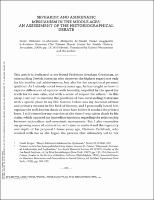Please use this identifier to cite or link to this item:
https://hdl.handle.net/20.500.12202/9234| Title: | Sephardic and Ashkenazic messianism in the Middle Ages: An assessment of the historiographical debate |
| Authors: | Berger, David |
| Keywords: | Jewish messianism Sephardic messianism Ashkenazic messianism Messianic era (Judaism) Intercultural communication --Religious aspects --Judaism. |
| Issue Date: | 2011 |
| Publisher: | Academic Studies Press |
| Citation: | Berger, D. (2011). Sephardic and Ashkenazic messianism in the Middle Ages: An assessment of the historiographical debate. In book.ebook Cultures in collision and conversation: essays in the intellectual history of the Jews (pp. 289-311). Academic Studies Press. |
| Series/Report no.: | Bernard Revel Faculty Publications;2011 |
| Abstract: | We have examined a truly gripping historical and historiographical issue. After the criticisms presented both in this article and in Carlebach's lecture, Cohen's famous thesis is reduced to the point where it stands on two factual claims: (1) In medieval Spain and the Middle East, we find messianic figures; but in Ashkenaz, we find none. (2) Speculative messianic thought, including variegated calculations of the End, is characteristic specifically of Sephardic communities . It is not impossible that Cohen was correct in his attempt to associate the presence or absence of messianic figures with varying approaches to faith and thought; however, the suggested connection is not straightforward, since he must assume that rationalism created movements only indirectly. Moreover, not all the messianic claimants appeared in rationalistic environments. It is consequently preferable to turn to other considerations. In Spain and the Middle East, messianic figures occasionally appeared, sometimes as a result of influences that we can identify, or at least surmise, such as the Shiite environment or the turmoil in Yemen; but even when we do not have a good explanation for a particular movement, there is no basis for perplexity regarding the rise of a few small movements over the course of many generations. The real question is why there were no messianic figures in Ashkenaz, and here we may perhaps proffer the modest suggestions that I have proposed. Even when small communities grow to some extent over the course of time, patterns of messianic thought and expectation formed over the course of generations do not change easily, especially in light of the continuing authority and influence of the rabbinic leadership, which was very wary of embracing messianic figures. In sum, it may well be that the communal profile that characterized Ashkenazic Jewry also determined its messianic profile . (from Conclusion) |
| Description: | Book chapter |
| URI: | https://ezproxy.yu.edu/login?url=https://search.ebscohost.com/login.aspx?direct=true&AuthType=ip,sso&db=nlebk&AN=474924&site=eds-live&scope=site&ebv=EB&ppid=pp_289 https://hdl.handle.net/20.500.12202/9234 |
| ISBN: | 9781618110602 |
| Appears in Collections: | Bernard Revel Graduate School of Jewish Studies (BRGS): Faculty Publications |
Files in This Item:
| File | Description | Size | Format | |
|---|---|---|---|---|
| David Berger Sephardic and Ashkenazic messianism 289-311 In Cultures in Collision 2011.pdf | 5.5 MB | Adobe PDF |  View/Open |
This item is licensed under a Creative Commons License

